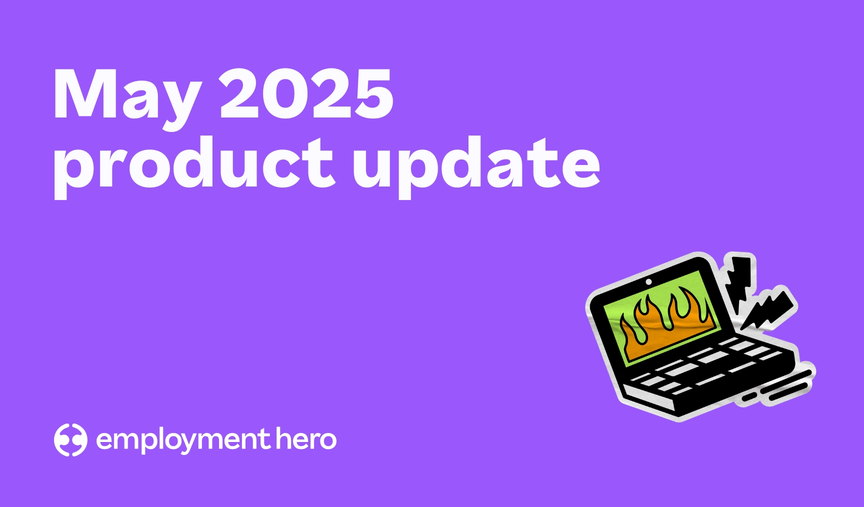How leaders can overcome the challenges of a hybrid workforce
A distributed or hybrid workforce is the way of the future. Here’s how to make it work for your business.

Contents
Hybrid teams are the way of the future. With many teams recently shifting to remote work and heading to the office a few days a week, it’s a model that’s working for everyone.
It allows for flexibility, collaboration, deep work and autonomy. If you ask us, it’s all the things that make up a highly engaged and top-performing employee and who doesn’t want that?
As we move forward, it’s only expected that we will see more blended or hybrid workforces. This hybrid workplace model allows employees the option to work onsite or from home and achieve a better work-life balance.
It’s the ability of the employer to empower their employees to choose how, where, and when they choose to work. While many of us have become accustomed to working remotely, many businesses are still ironing out issues.
What is a hybrid model workplace?
A hybrid working style would see the office as ‘optional’. Employees can attend the on-site office space if they wish, but they can also work remotely from home.
For some hybrid employees, they may wish to use the physical location as a collaborative space whilst completing ‘deep work’ at home.
For others, office space could be used as a casual workspace for those who want to use it.
There’s also the alternative – those who will never use it, as they plan to live in different cities or countries across the globe.
What are the benefits of a hybrid workplace?
Before we jump into the challenges of hybrid working, it’s definitely worth revisiting the benefits of adopting the hybrid work model.
What makes flexible work such an appealing option? The results from our remote work report weren’t that surprising…
Our two cents? Hybrid working is the best of both worlds, combining the flexibility of remote work and the increased productivity of in-person collaboration.
- Reduced commute – Respondents flagged that they wanted to continue avoiding the commute and being regularly interrupted at their desks.
- Physical isolation – They were also happy not to be around sick colleagues – a very understandable desire following what we’ve all been through!
- Better work-life balance – Being able to save time from their commute allows remote employees additional time to get work done, which allows employees to clock off on time.
The biggest drawcard of the hybrid working model is the fact that it offers flexibility to your team. Remote employees can choose how and where they want to work depending on their personal circumstances, current situation and mood.

Work how and where you want to work.
What are the challenges of hybrid working?
Even though hybrid working is a fantastic way to run a team, there are challenges that leaders will face.
1. Connecting a distributed team
Have you ever run into a colleague in the office kitchen and had a really pleasant and insightful conversation? Maybe you’ve even followed them up after your chat to get their advice about a piece of work or an upcoming project.
For all of the benefits of working from home, these random conversations can be one of the elements of the workplace that are really missed. Collaboration, both intentional and unintentional, can flow much easier when you have someone’s in-person energy to bounce off.
This challenge is a multi-faceted one for a hybrid workforce.
Firstly, your team will miss out on having spontaneous discussions with all of their colleagues.
Secondly, those who come into the office may find themselves connecting with their teammates more often, building stronger bonds which may make remote teammates feel isolated.
What can leaders do?
There are plenty of measures that leaders can use to tackle this one. Wherever possible, take a “remote-first” approach to all meetings. Instead of having all the in-office employees attend the meeting together and dial in the remote workers, get employees to dial in from their desks and start hosting hybrid meetings.
It can be hard to express your ideas from a laptop when everyone else is there in person, this measure makes sure that everyone has their ideas heard. Every couple of weeks allocate time in the workday for team-building activities.
Just like in-person activities, these can help team members get to know each other and flex their team working muscles!
Not sure where to start? We’ve put together a guide of 39 (yes 39!) fun games to try. As well as encouraging group bonding, one-on-one time is crucial to having that “watercooler” socialising feeling. But how can we make these feel random?
Whilst it may not be completely spontaneous, getting into a regular social routine will do wonders for your team’s relationships.
Read more: The best remote working software for virtual teams

One team, one dream.
2. Decentralising company operations
We’re so used to thinking of a company having a set headquarters – the office space is a physical location where work happens. The idea of having your employees work across several locations, from different cities to different countries, is a bit harder to imagine.
When running a hybrid workplace, you’ll have employees completing all kinds of responsibilities from various locations. In order to facilitate this, it’s important to let go of HQ as being the place where the most important tasks take place.
All important information needs to be easily accessible to employees wherever they may be.
Read more: Prepare your employees with this work-from-home checklist
What can leaders do?
The last thing you want to be doing is relying on email (or even worse – snail mail) to exchange important documents or information. If you’re predominantly sourcing files from a server that’s based in the ‘main’ office or still filing paper documents in cabinets, you might be creating a lot more work for your entire team.
If possible, make sure that most (if not all) of your business information and operations are cloud-based. Implement cloud storage and online collaborative documents for your whole team. If your employees do not currently have the skills to use this technology, the investment will be well worth it in time saved.
3. Keeping tabs on employee wellness
If someone is struggling with mental, physical, or other aspects of their personal wellness, it can be difficult to identify from a surface level. It can be even harder to recognise a drop in wellbeing when you’re not physically in the same location.
From a mental health perspective, it can be especially difficult to look out for the signs of a drop in employee engagement – which could include becoming withdrawn and antisocial or changes in appearance.
It’s incredibly challenging to keep track of these things when you’re only seeing the Zoom snapshot of a teammate.
Similarly, it can be tricky with hybrid teams to monitor your staff member’s work-life balance.
When all of your work is (literally) on your doorstep, there’s little to stop stressed-out workers from working into the night. Alternatively, if managers are working remotely, it can be difficult to see if in-office employees are pulling long hours after the workday is over.
What can leaders do?
Strong connections between managers and staff can be an effective antidote to wellbeing issues. Understandably, your staff members are unlikely to make it clear in a team meeting that they’re not doing well, but in a private format they’re more likely to open up.
We’re huge advocates of the regular 1:1 meeting between managers and their direct reports, not only because they’re a great opportunity to exchange work-related updates but because they’re a confidential space to flag any other issues.
De-stigmatise any discussions about mental health and take an authentic interest in wellbeing.
Do they need increased flexibility? Help with prioritising work? Increased support as they move through a challenging time?
These are all things that can be easily and privately arranged through a caring manager.
💡 Take this practice of de-stigmatising all areas of health to the rest of your company culture. An effective workplace wellness program can help you promote wellbeing for all staff.
4. Welcoming new employees without physically meeting them
One of the more surreal elements of having a remote workforce is the fact that employees might not physically meet some of their closest teammates. Sometimes they may not meet them until the next major work event sometimes they may not meet them – ever!
From the new employee’s perspective, starting a new role in your own home can be similarly strange and stressful!
If your new workplace is disorganised with your onboarding, you might find yourself a bit stuck and without the option of seeking help from your nearest colleague.
This can start your new employee off on the wrong foot and risk having them instantly feeling disengaged with the business.
Read more: Checklist for hiring international employees
What can leaders do?
Create a bespoke online induction for your new starters. A remote induction shouldn’t just be a virtual version of your regular induction program.
As well as capturing classic elements of an induction program – like collecting essential details, introducing the new starter to the team and sharing company values – it should give the incoming employee a complete understanding of the company’s culture and operations without stepping foot on site.
💡 Get organised for a killer online induction with our Remote Employee Onboarding Checklist.
The key to transitioning to a hybrid workplace
Yes, there are challenges in running a successful hybrid workforce. But is it absolutely worth overcoming them for the happiness of your team and the good of your business? Absolutely.
Companies with a successful hybrid workplace model in place can often see improved employee performance, along with cost savings from not having to rent a building for all your employees.
Simple leadership solutions will help your staff thrive in the hybrid model. If you prioritise connection, invest in tech and dial up the trust – you can’t go wrong.
At Employment Hero, we use a range of techniques to keep morale and productivity levels high, such as:
- Turning videos on for engagement and connection
- Regular 1:1s across the team
- A culture of reward and recognition! 🎉
- Employee surveys to discover what the business can improve on
- Theming-up All-Hands provides non-work-related relief
- Virtual hangouts on Zoom to enable cross-team collaboration
- Social sharing channels on Slack to keep the day fun
Want to implement these for your own company? Employment Hero makes running hybrid teams easy with our extensive people management functionality. Book a demo today to find out how we can help!
Related Resources
-
 Read more: Product Update: May 2025
Read more: Product Update: May 2025Product Update: May 2025
Follow our May 2025 product update as we share all of the latest and greatest features we’ve released over the…
-
 Read more: Product Update: April 2025
Read more: Product Update: April 2025Product Update: April 2025
Follow our April 2025 product update as we share all of the latest and greatest features we’ve released over the…
-
 Read more: Product Update: March 2025
Read more: Product Update: March 2025Product Update: March 2025
Follow our March 2025 product update as we share all of the latest and greatest features we’ve released over the…








